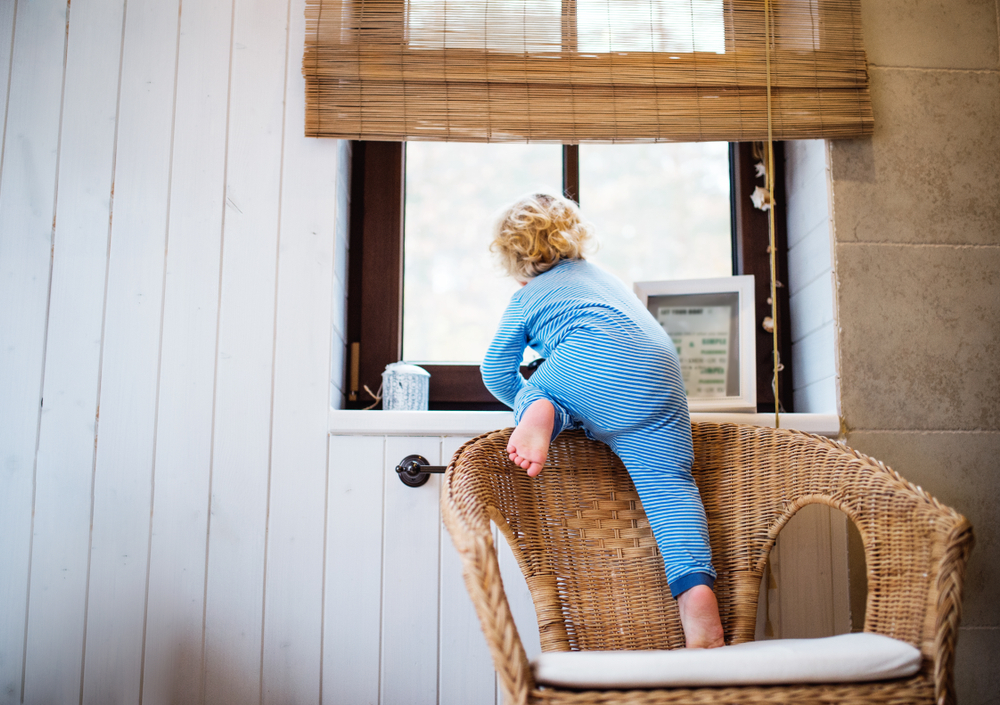Tips for Preventing Falls: Newborns to Toddlers
Updated November 4th, 2019

A fall can happen in a blink of an eye. The good news is that you can help prevent falls and injuries if you know what puts your child at risk.
Newborns
Did you know that being dropped is the most common cause of fall-injury in newborns? This might seem unthinkable, but it happens because:
In the hospital
- After delivery, exhaustion, pain medication or Caesarean birth put new mothers (birth parent) at risk of accidentally dropping baby.
- Tired new parents may fall asleep while holding or feeding baby and lose their grip.
You can help keep your baby safe in the hospital by:
- Always putting your baby on his back in the bassinet to sleep
- Telling your nurse if you are dizzy or drowsy
- Being aware of wet floors, spills or equipment which may cause you to slip or fall
- Always transporting your baby in the bassinet. This is a hospital policy. Do not carry your baby in your arms when you are outside your room.
Hospital staff will work with you to make sure that you and your baby have lots of opportunity to bond and breastfeed, while keeping your baby as safe as possible.
In the home
New parents are often very tired, may be multi-tasking and can be distracted.
You can help keep your baby safe at home by:
- For sleep:
- Lay your baby on her back in the crib if you are feeling sleepy so you don’t fall asleep with her in your arms .
- After feeding your baby at night put her in the crib before you fall asleep
- Around home:
- Wear non-slip socks or shoes in the house to avoid slipping while carrying baby.
- Be careful when using the stairs while holding your baby.
- A wet baby is a slippery baby so take extra care at bath time.
- If you are carrying your newborn in a car seat, be sure the harness straps are securely fastened.
- If using a sling, carrier or wrap to carry your baby, make sure your child is supported and snug. Have a good hold on your baby before you bend over.
- When you are not holding your baby, it is best to put him in a crib, cradle, bassinet or playpen or on the floor. Babies can fall from beds, couches and other furniture.
Preventing falls in the first year
Your baby will grow and develop so much in the first year. Her abilities will change quickly. Each new movement can come with new risks. As your child grows and learns to walk, falling over is normal. But falls from heights can result in an injury. Some examples are falling off furniture, down stairs and out of windows. Stay one step ahead of your child to help keep them safe.
| Your baby will soon be… | To keep your baby safe… |
|---|---|
| Rolling over | Always keep a hand on your baby when on a change table, sofa, bed or other raised surface. |
| Pulling up | To prevent from her from falling out of the crib, lower the crib mattress before baby can push up on hands and knees. |
| Crawling | To protect your baby from falling downstairs, install wall-mounted gates at the top of the stairs and pressure-mounted gates at the bottom of the stairs. |
When using baby equipment
- Always use the safety straps on strollers, infant chairs, swings, high chairs, kitchen booster seats and change tables.
- Avoid putting your child in a bouncy chair, baby carrier or car seat on a table, counter or other raised surface. Babies should be taken out of a car seat once they are inside the home. It is not safe for a baby to sleep in a car seat outside of a car.
- Don’t use a wheeled baby walker. Wheeled walkers are banned in Canada because babies have died or become seriously injured falling downstairs while using them.
Toddlers
Toddlers learn through play, exploring and mimicking. Keep teaching your child about safety, but remember your child is still learning and won’t always remember to follow the rules. Your supervision is very important in keeping your toddler safe. Give your child a safe place to learn, explore or try out something new.
Here are some tips to help prevent the most common causes of toddler falls.
| Your child will soon be able to… | To keep your child safe… |
|---|---|
| Climb up stools, chairs or other furniture |
|
| Climb out of crib |
|
| Climb near windows and balconies |
|
| Climb stairs |
|
| Climb on Beds |
|
| Play |
|